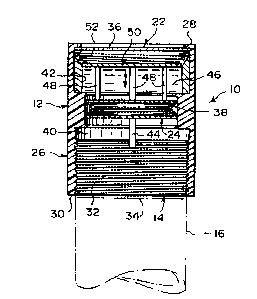Some of the information on this Web page has been provided by external sources. The Government of Canada is not responsible for the accuracy, reliability or currency of the information supplied by external sources. Users wishing to rely upon this information should consult directly with the source of the information. Content provided by external sources is not subject to official languages, privacy and accessibility requirements.
Any discrepancies in the text and image of the Claims and Abstract are due to differing posting times. Text of the Claims and Abstract are posted:
| (12) Patent: | (11) CA 2269787 |
|---|---|
| (54) English Title: | VISUAL TIRE CAP PRESSURE GAUGE |
| (54) French Title: | BOUCHON CONTROLEUR DE PRESSION D'UN PNEU A LECTURE DIRECTE |
| Status: | Expired and beyond the Period of Reversal |
| (51) International Patent Classification (IPC): |
|
|---|---|
| (72) Inventors : |
|
| (73) Owners : |
|
| (71) Applicants : |
|
| (74) Agent: | OSLER, HOSKIN & HARCOURT LLP |
| (74) Associate agent: | |
| (45) Issued: | 2002-07-16 |
| (86) PCT Filing Date: | 1996-10-28 |
| (87) Open to Public Inspection: | 1998-05-07 |
| Examination requested: | 1999-04-23 |
| Availability of licence: | N/A |
| Dedicated to the Public: | N/A |
| (25) Language of filing: | English |
| Patent Cooperation Treaty (PCT): | Yes |
|---|---|
| (86) PCT Filing Number: | PCT/US1996/017266 |
| (87) International Publication Number: | WO 1998018639 |
| (85) National Entry: | 1999-04-23 |
| (30) Application Priority Data: | None |
|---|
A visual tire cap pressure gauge (10) which comprises a cap member (12). A
structure within the cap member (12) is for securing the cap member to a valve
stem (16) on a tire (18) in a motor vehicle (20). A lens (22) is mounted in a
top end of the cap member (12). An assembly (24) within the cap is for
visually indicating when air pressure within the tire (18) drops below a set
point, so as to enable a person at a glance to tell if the tire needs more air.
Un bouchon contrôleur de pression d'un pneu à lecture directe (10) comprend un capuchon (12). Une structure à l'intérieur du capuchon (12) sert à fixer le capuchon sur une tige de soupape (16) d'un pneu (18) de véhicule à moteur (20). Une lentille (22) est monté sur une extrémité supérieure du capuchon (12). Un système (24) à l'intérieur du bouchon affiche directement le niveau de pression d'air dans le pneu (18) lorsque ce niveau descend au-dessous d'un point donné, ce qui permet à une personne d'apprécier d'un coup d'oeil si le pneu nécessite plus d'air.
Note: Claims are shown in the official language in which they were submitted.
Note: Descriptions are shown in the official language in which they were submitted.

2024-08-01:As part of the Next Generation Patents (NGP) transition, the Canadian Patents Database (CPD) now contains a more detailed Event History, which replicates the Event Log of our new back-office solution.
Please note that "Inactive:" events refers to events no longer in use in our new back-office solution.
For a clearer understanding of the status of the application/patent presented on this page, the site Disclaimer , as well as the definitions for Patent , Event History , Maintenance Fee and Payment History should be consulted.
| Description | Date |
|---|---|
| Inactive: Agents merged | 2013-10-24 |
| Time Limit for Reversal Expired | 2003-10-28 |
| Letter Sent | 2002-10-28 |
| Grant by Issuance | 2002-07-16 |
| Inactive: Cover page published | 2002-07-15 |
| Inactive: Final fee received | 2002-05-02 |
| Pre-grant | 2002-05-02 |
| Notice of Allowance is Issued | 2001-11-13 |
| Notice of Allowance is Issued | 2001-11-13 |
| Letter Sent | 2001-11-13 |
| Inactive: Approved for allowance (AFA) | 2001-10-30 |
| Inactive: Cover page published | 1999-07-22 |
| Inactive: First IPC assigned | 1999-06-10 |
| Inactive: Acknowledgment of national entry - RFE | 1999-05-27 |
| Application Received - PCT | 1999-05-25 |
| All Requirements for Examination Determined Compliant | 1999-04-23 |
| Request for Examination Requirements Determined Compliant | 1999-04-23 |
| Application Published (Open to Public Inspection) | 1998-05-07 |
There is no abandonment history.
The last payment was received on 2001-10-22
Note : If the full payment has not been received on or before the date indicated, a further fee may be required which may be one of the following
Please refer to the CIPO Patent Fees web page to see all current fee amounts.
| Fee Type | Anniversary Year | Due Date | Paid Date |
|---|---|---|---|
| Basic national fee - small | 1999-04-23 | ||
| MF (application, 2nd anniv.) - small | 02 | 1998-10-28 | 1999-04-23 |
| Request for examination - small | 1999-04-23 | ||
| MF (application, 3rd anniv.) - small | 03 | 1999-10-28 | 1999-09-15 |
| MF (application, 4th anniv.) - small | 04 | 2000-10-30 | 2000-10-20 |
| MF (application, 5th anniv.) - small | 05 | 2001-10-29 | 2001-10-22 |
| Final fee - small | 2002-05-02 |
Note: Records showing the ownership history in alphabetical order.
| Current Owners on Record |
|---|
| CRAIG CUMMINGS |
| Past Owners on Record |
|---|
| None |